oil additives MERCEDES-BENZ GLE COUPE 2015 Owners Manual
[x] Cancel search | Manufacturer: MERCEDES-BENZ, Model Year: 2015, Model line: GLE COUPE, Model: MERCEDES-BENZ GLE COUPE 2015Pages: 393, PDF Size: 12.71 MB
Page 6 of 393
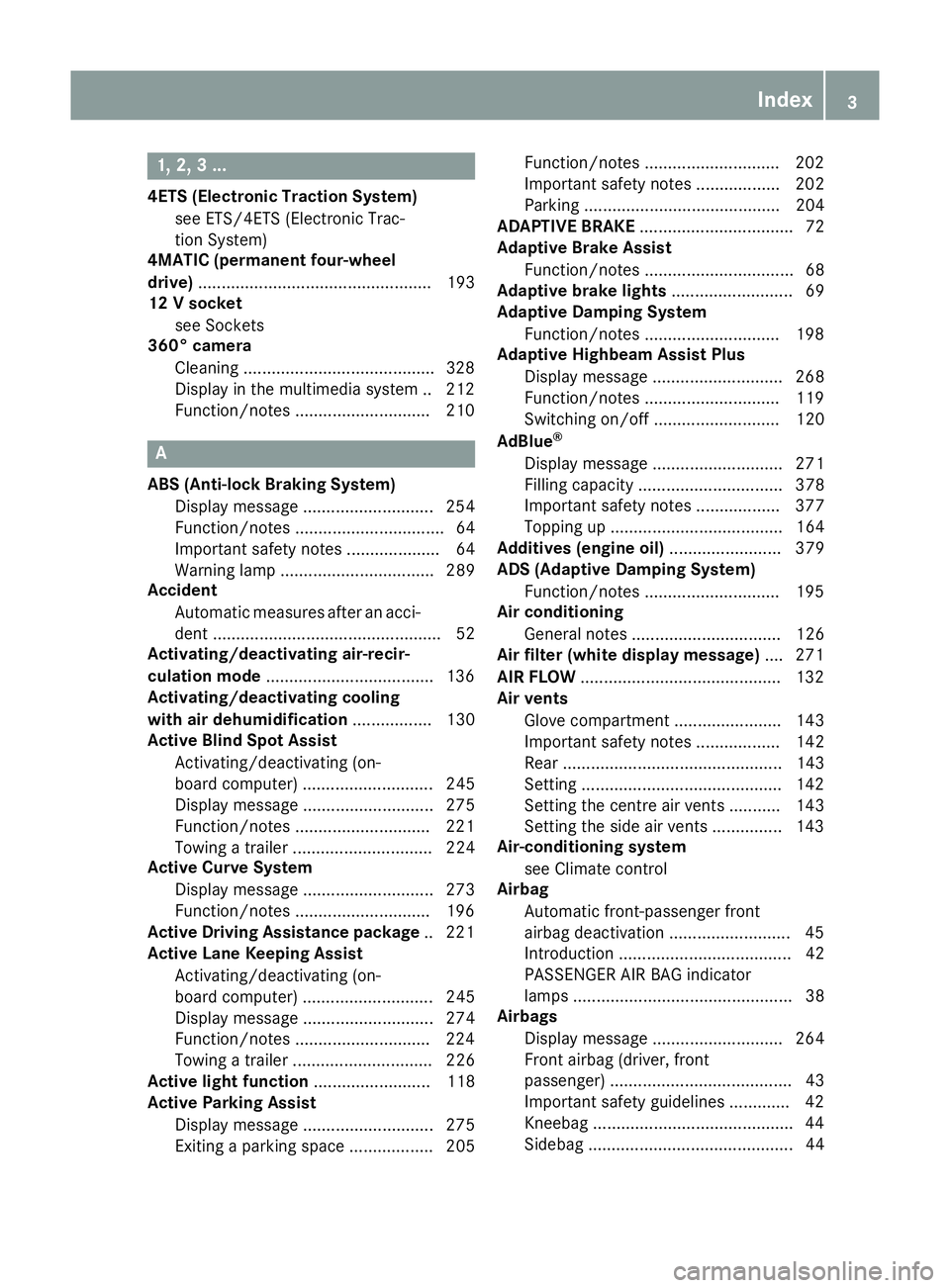
1, 2, 3 ...
4ETS (Electronic Traction System) see ETS/4ETS (Electronic Trac-
tion System)
4MATIC (permanent four-wheel
drive) .................................................. 193
12 V socket
see Sockets
360° camera
Cleaning .........................................3 28
Display in the multimedia system .. 212
Function/notes ............................ .210 A
ABS (Anti-lock Braking System) Display message ............................ 254
Function/notes ................................ 64
Important safety notes .................... 64
Warning lamp ................................. 289
Accident
Automatic measures after an acci-
dent ................................................. 52
Activating/deactivating air-recir-
culation mode ................................... .136
Activating/deactivating cooling
with air dehumidification ................. 130
Active Blind Spot Assist
Activating/deactivating (on-
board computer) ............................ 245
Display message ............................ 275
Function/notes ............................ .221
Towing a trailer .............................. 224
Active Curve System
Display message ............................ 273
Function/notes ............................ .196
Active Driving Assistance package .. 221
Active Lane Keeping Assist
Activating/deactivating (on-
board computer) ............................ 245
Display message ............................ 274
Function/notes ............................ .224
Towing a trailer .............................. 226
Active light function ......................... 118
Active Parking Assist
Display message ............................ 275
Exiting a parking space .................. 205 Function/notes ............................
.202
Important safety notes .................. 202
Parking .......................................... 204
ADAPTIVE BRAKE ................................. 72
Adaptive Brake Assist
Function/notes ................................ 68
Adaptive brake lights .......................... 69
Adaptive Damping System
Function/notes ............................ .198
Adaptive Highbeam Assist Plus
Display message ............................ 268
Function/notes ............................ .119
Switching on/off ........................... 120
AdBlue ®
Display message ............................ 271
Filling capacity ............................... 378
Important safety notes .................. 377
Topping up ..................................... 164
Additives (engine oil) ........................ 379
ADS (Adaptive Damping System)
Function/notes ............................ .195
Air conditioning
General notes ................................ 126
Air filter (white display message) .... 271
AIR FLOW .......................................... .132
Air vents
Glove compartment ....................... 143
Important safety notes .................. 142
Rear ............................................... 143
Setting .......................................... .142
Setting the centre air vents ........... 143
Setting the side air vents .............. .143
Air-conditioning system
see Climate control
Airbag
Automatic front-passenger front
airbag deactivatio n .......................... 45
Introduction ..................................... 42
PASSENGER AIR BAG indicator
lamps ............................................... 38
Airbags
Display message ............................ 264
Front airbag (driver, front
passenger) ....................................... 43
Important safety guidelines ............. 42
Kneebag .......................................... .44
Sidebag ............................................ 44 Index
3
Page 12 of 393
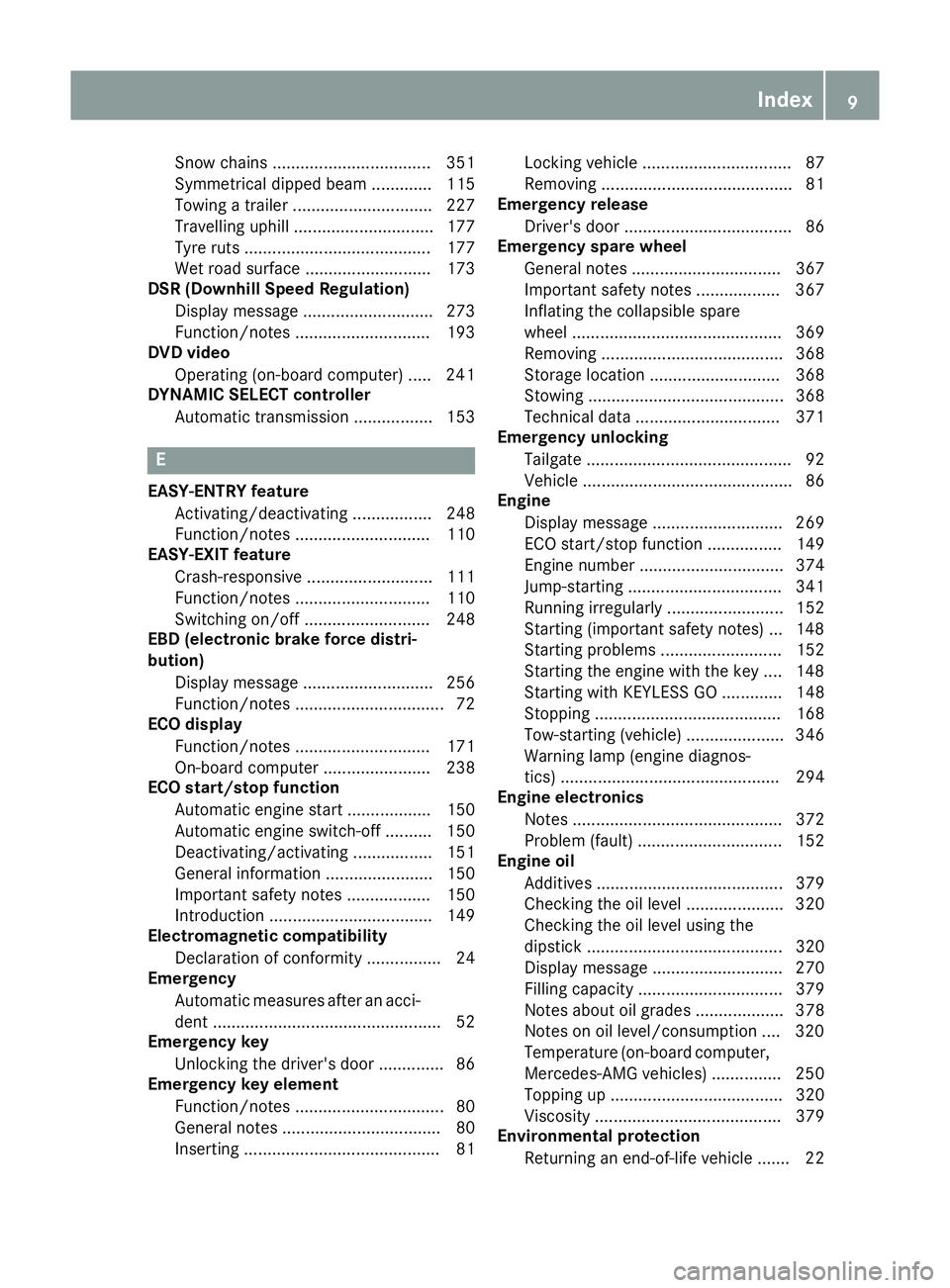
Snow chains .................................. 351
Symmetrical dipped beam ............. 115
Towing a trailer .............................. 227
Travelling uphill .............................. 177
Tyre ruts ........................................ 177
Wet road surface ........................... 173
DSR (Downhill Speed Regulation)
Display message ............................ 273
Function/note s............................. 193
DVD video
Operating (on-board computer) ..... 241
DYNAMIC SELECT controller
Automatic transmission ................. 153 E
EASY-ENTRY feature Activating/deactivating ................. 248
Function/note s............................. 110
EASY-EXIT feature
Crash-responsive ........................... 111
Function/note s............................. 110
Switching on/of f........................... 248
EBD (electronic brake force distri-
bution)
Display message ............................ 256
Function/note s................................ 72
ECO display
Function/note s............................. 171
On-board computer ....................... 238
ECO start/stop function
Automatic engine start .................. 150
Automatic engine switch-off .......... 150
Deactivating/activating ................. 151
General information ....................... 150
Important safety notes .................. 150
Introduction ................................... 149
Electromagnetic compatibility
Declaration of conformity ................ 24
Emergency
Automatic measures after an acci-
dent ................................................. 52
Emergency key
Unlocking the driver's door .............. 86
Emergency key element
Function/note s................................ 80
General notes .................................. 80
Inserting .......................................... 81 Locking vehicle ................................ 87
Removing ......................................... 81
Emergency release
Driver's door .................................... 86
Emergency spare wheel
General notes ................................ 367
Important safety notes .................. 367
Inflating the collapsible spare
wheel ............................................. 369
Removing ....................................... 368
Storage location ............................ 368
Stowing .......................................... 368
Technical data ............................... 371
Emergency unlocking
Tailgate ............................................ 92
Vehicle ............................................. 86
Engine
Display message ............................ 269
ECO start/stop function ................ 149
Engine number ............................... 374
Jump-starting ................................. 341
Running irregularly ......................... 152
Starting (important safety notes )... 148
Starting problems .......................... 152
Starting the engine with the key .... 148
Starting with KEYLESS GO ............. 148
Stopping ........................................ 168
Tow-starting (vehicle) ..................... 346
Warning lamp (engine diagnos-
tics) ............................................... 294
Engine electronics
Notes ............................................. 372
Problem (fault) ............................... 152
Engine oil
Additives ........................................ 379
Checking the oil level ..................... 320
Checking the oil level using the
dipstick .......................................... 320
Display message ............................ 270
Filling capacity ............................... 379
Notes about oil grade s................... 378
Notes on oil level/consumption .... 320
Temperature (on-board computer,
Mercedes-AMG vehicles) ............... 250
Topping up ..................................... 320
Viscosity ........................................ 379
Environmental protection
Returning an end-of-life vehicle ....... 22 Index
9
Page 168 of 393
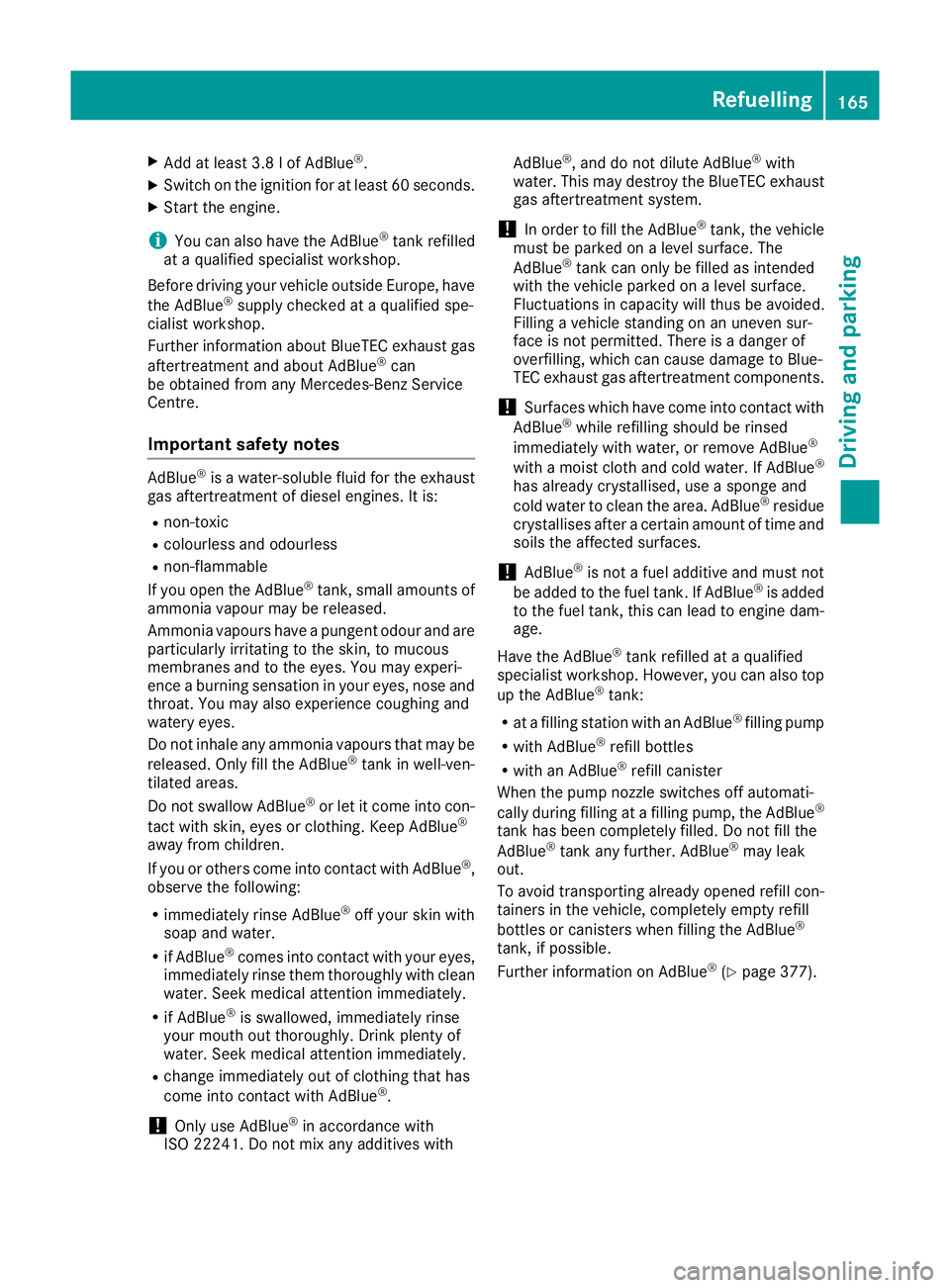
X
Add at least 3.8 lof AdBlue ®
.
X Switch on the ignition for at least 60 seconds.
X Start the engine.
i You can also have the AdBlue ®
tank refilled
at a qualified specialist workshop.
Before driving your vehicle outside Europe, have
the AdBlue ®
supply checked at a qualified spe-
cialist workshop.
Further information about BlueTEC exhaust gas
aftertreatment and about AdBlue ®
can
be obtained from any Mercedes-Benz Service
Centre.
Important safety notes AdBlue
®
is a water-soluble fluid for the exhaust
gas aftertreatment of diesel engines. It is:
R non-toxic
R colourless and odourless
R non-flammable
If you open the AdBlue ®
tank, small amounts of
ammonia vapour may be released.
Ammonia vapours have a pungent odour and are
particularly irritating to the skin, to mucous
membranes and to the eyes. You may experi-
ence a burning sensation in your eyes, nose and throat. You may also experience coughing and
watery eyes.
Do not inhale any ammonia vapours that may be
released. Only fill the AdBlue ®
tank in well-ven-
tilated areas.
Do not swallow AdBlue ®
or let it come into con-
tact with skin, eyes or clothing. Keep AdBlue ®
away from children.
If you or others come into contact with AdBlue ®
,
observe the following:
R immediately rinse AdBlue ®
off your skin with
soap and water.
R if AdBlue ®
comes into contact with your eyes,
immediately rinse them thoroughly with clean water. Seek medical attention immediately.
R if AdBlue ®
is swallowed, immediately rinse
your mouth out thoroughly. Drink plenty of
water. Seek medical attention immediately.
R change immediately out of clothing that has
come into contact with AdBlue ®
.
! Only use AdBlue ®
in accordance with
ISO 22241. Do not mix any additives with AdBlue
®
, and do not dilute AdBlue ®
with
water. This may destroy the BlueTEC exhaust
gas aftertreatment system.
! In order to fill the AdBlue ®
tank, the vehicle
must be parked on a level surface. The
AdBlue ®
tank can only be filled as intended
with the vehicle parked on a level surface.
Fluctuations in capacity will thus be avoided.
Filling a vehicle standing on an uneven sur-
face is not permitted. There is a danger of
overfilling, which can cause damage to Blue-
TEC exhaust gas aftertreatment components.
! Surfaces which have come into contact with
AdBlue ®
while refilling should be rinsed
immediately with water, or remove AdBlue ®
with a moist cloth and cold water. If AdBlue ®
has already crystallised, use a sponge and
cold water to clean the area. AdBlue ®
residue
crystallises after a certain amount of time and soils the affected surfaces.
! AdBlue ®
is not a fuel additive and must not
be added to the fuel tank. If AdBlue ®
is added
to the fuel tank, this can lead to engine dam-
age.
Have the AdBlue ®
tank refilled at a qualified
specialist workshop. However, you can also top
up the AdBlue ®
tank:
R at a filling station with an AdBlue ®
filling pump
R with AdBlue ®
refill bottles
R with an AdBlue ®
refill canister
When the pump nozzle switches off automati-
cally during filling at a filling pump, the AdBlue ®
tank has been completely filled. Do not fill the
AdBlue ®
tank any further. AdBlue ®
may leak
out.
To avoid transporting already opened refill con-
tainers in the vehicle, completely empty refill
bottles or canisters when filling the AdBlue ®
tank, if possible.
Further information on AdBlue ®
(Y page 377). Refuelling
165Driving and parking Z
Page 324 of 393
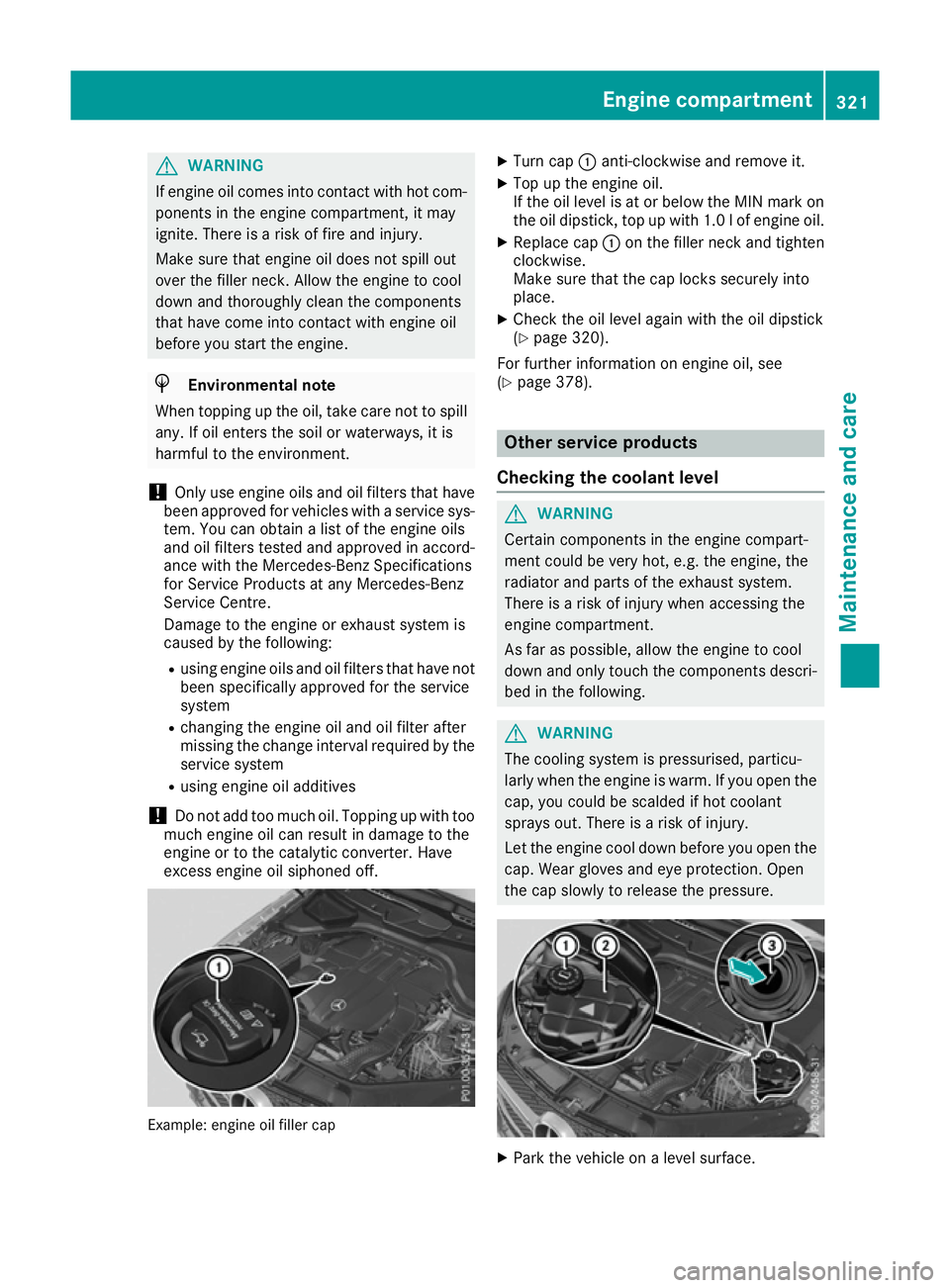
G
WARNING
If engine oil comes into contact with hot com- ponents in the engine compartment, it may
ignite. There is a risk of fire and injury.
Make sure that engine oil does not spill out
over the filler neck. Allow the engine to cool
down and thoroughly clean the components
that have come into contact with engine oil
before you start the engine. H
Environmental note
When topping up the oil, take care not to spill
any. If oil enters the soil or waterways, it is
harmful to the environment.
! Only use engine oils and oil filters that have
been approved for vehicles with a service sys-
tem. You can obtain a list of the engine oils
and oil filters tested and approved in accord-
ance with the Mercedes-Benz Specifications
for Service Products at any Mercedes-Benz
Service Centre.
Damage to the engine or exhaust system is
caused by the following:
R using engine oils and oil filters that have not
been specifically approved for the service
system
R changing the engine oil and oil filter after
missing the change interval required by the
service system
R using engine oil additives
! Do not add too much oil. Topping up with too
much engine oil can result in damage to the
engine or to the catalytic converter. Have
excess engine oil siphoned off. Example: engine oil filler cap X
Turn cap :anti-clockwise and remove it.
X Top up the engine oil.
If the oil level is at or below the MIN mark on
the oil dipstick, top up with 1.0 lof engine oil.
X Replace cap :on the filler neck and tighten
clockwise.
Make sure that the cap locks securely into
place.
X Check the oil level again with the oil dipstick
(Y page 320).
For further information on engine oil, see
(Y page 378). Other service products
Checking the coolant level G
WARNING
Certain components in the engine compart-
ment could be very hot, e.g. the engine, the
radiator and parts of the exhaust system.
There is a risk of injury when accessing the
engine compartment.
As far as possible, allow the engine to cool
down and only touch the components descri- bed in the following. G
WARNING
The cooling system is pressurised, particu-
larly when the engine is warm. If you open the cap, you could be scalded if hot coolant
sprays out. There is a risk of injury.
Let the engine cool down before you open the
cap. Wear gloves and eye protection. Open
the cap slowly to release the pressure. X
Park the vehicle on a level surface. Engine compartment
321Maintenance and care Z
Page 377 of 393
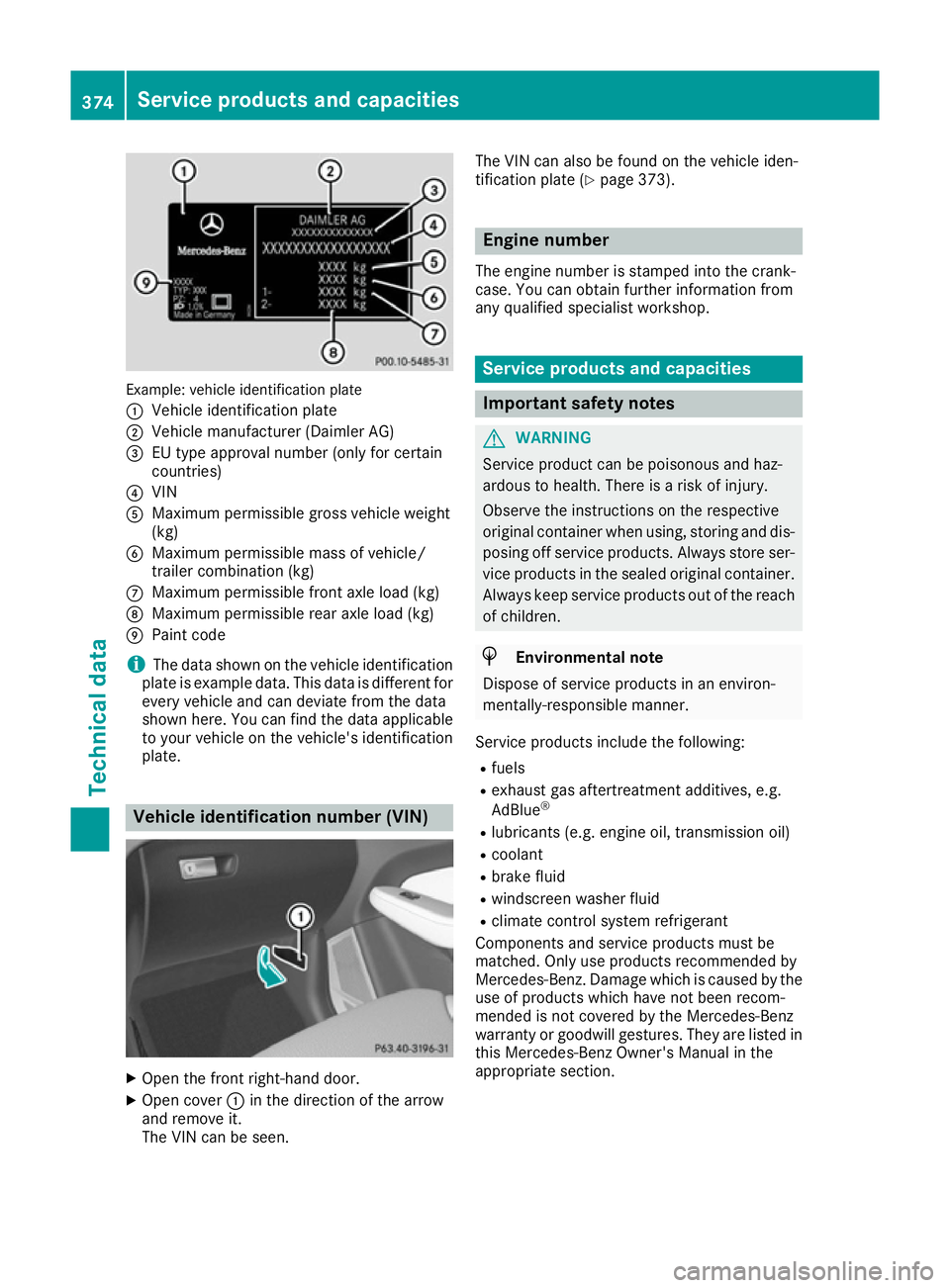
Example: vehicle identification plate
:
Vehicle identification plate
; Vehicle manufacturer (Daimler AG)
= EU type approval number (only for certain
countries)
? VIN
A Maximum permissible gross vehicle weight
(kg)
B Maximum permissible mass of vehicle/
trailer combination (kg)
C Maximum permissible front axle load (kg)
D Maximum permissible rear axle load (kg)
E Paint code
i The data shown on the vehicle identification
plate is example data. This data is different for
every vehicle and can deviate from the data
shown here. You can find the data applicable to your vehicle on the vehicle's identification
plate. Vehicle identification number (VIN)
X
Open the front right-hand door.
X Open cover :in the direction of the arrow
and remove it.
The VIN can be seen. The VIN can also be found on the vehicle iden-
tification plate (Y
page 373). Engine number
The engine number is stamped into the crank-
case. You can obtain further information from
any qualified specialist workshop. Service products and capacities
Important safety notes
G
WARNING
Service product can be poisonous and haz-
ardous to health. There is a risk of injury.
Observe the instructions on the respective
original container when using, storing and dis- posing off service products. Always store ser-
vice products in the sealed original container. Always keep service products out of the reach
of children. H
Environmental note
Dispose of service products in an environ-
mentally-responsible manner.
Service products include the following:
R fuels
R exhaust gas aftertreatment additives, e.g.
AdBlue ®
R lubricants (e.g. engine oil, transmission oil)
R coolant
R brake fluid
R windscreen washer fluid
R climate control system refrigerant
Components and service products must be
matched. Only use products recommended by
Mercedes-Benz. Damage which is caused by the
use of products which have not been recom-
mended is not covered by the Mercedes-Benz
warranty or goodwill gestures. They are listed in this Mercedes-Benz Owner's Manual in the
appropriate section. 374
Service products and capacitiesTechnical data
Page 380 of 393
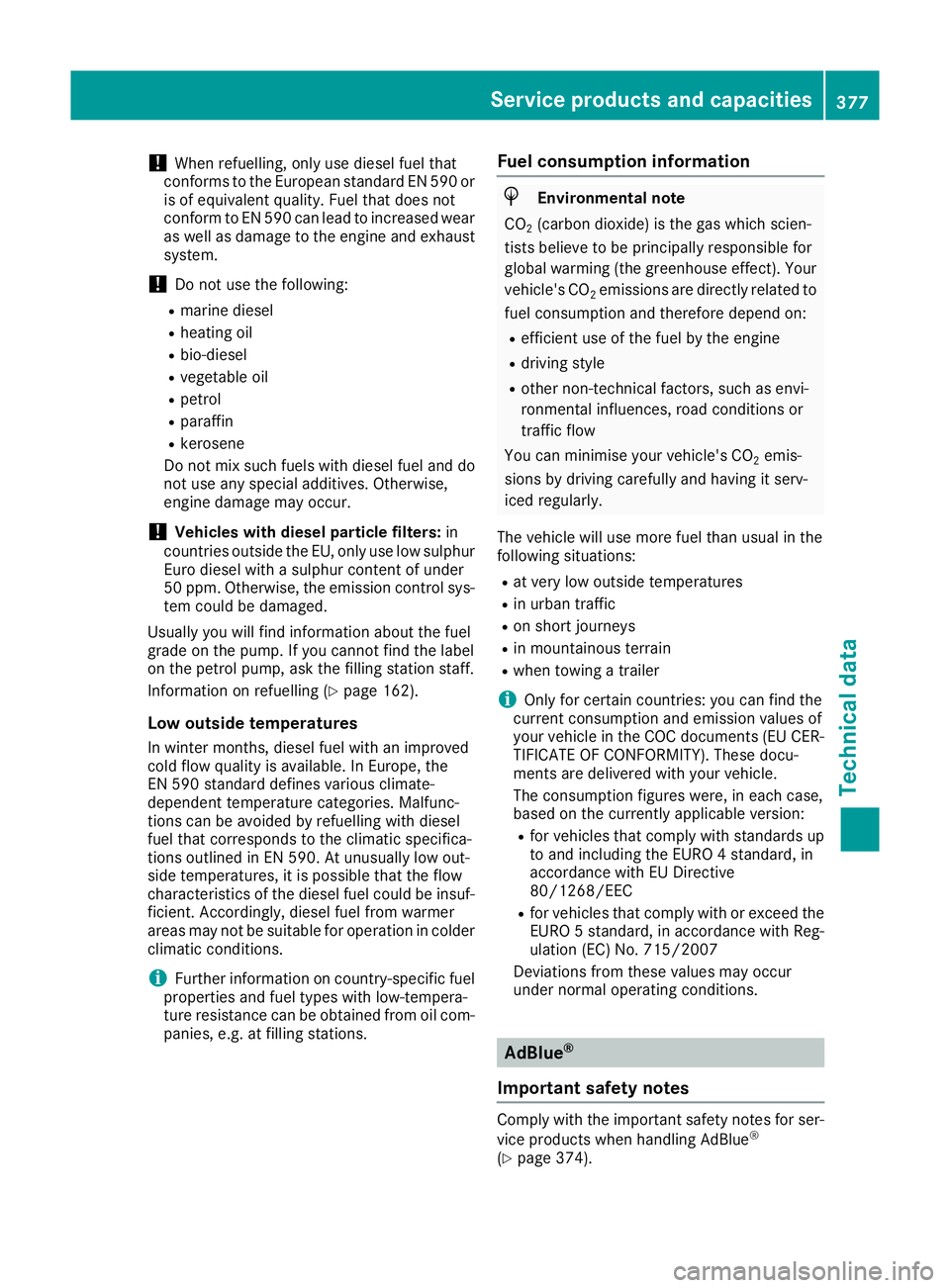
!
When refuelling, only use diesel fuel that
conforms to the European standard EN 590 or is of equivalent quality. Fuel that does not
conform to EN 590 can lead to increased wear
as well as damage to the engine and exhaust
system.
! Do not use the following:
R marine diesel
R heating oil
R bio-diesel
R vegetable oil
R petrol
R paraffin
R kerosene
Do not mix such fuels with diesel fuel and do
not use any special additives. Otherwise,
engine damage may occur.
! Vehicles with diesel particle filters:
in
countries outside the EU, only use low sulphur
Euro diesel with a sulphur content of under
50 ppm. Otherwise, the emission control sys- tem could be damaged.
Usually you will find information about the fuel
grade on the pump. If you cannot find the label
on the petrol pump, ask the filling station staff.
Information on refuelling (Y page 162).
Low outside temperatures In winter months, diesel fuel with an improved
cold flow quality is available. In Europe, the
EN 590 standard defines various climate-
dependent temperature categories. Malfunc-
tions can be avoided by refuelling with diesel
fuel that corresponds to the climatic specifica-
tions outlined in EN 590. At unusually low out-
side temperatures, it is possible that the flow
characteristics of the diesel fuel could be insuf- ficient. Accordingly, diesel fuel from warmer
areas may not be suitable for operation in colder
climatic conditions.
i Further information on country-specific fuel
properties and fuel types with low-tempera-
ture resistance can be obtained from oil com-
panies, e.g. at filling stations. Fuel consumption information H
Environmental note
CO 2(carbon dioxide) is the gas which scien-
tists believe to be principally responsible for
global warming (the greenhouse effect). Your
vehicle's CO 2emissions are directly related to
fuel consumption and therefore depend on:
R efficient use of the fuel by the engine
R driving style
R other non-technical factors, such as envi-
ronmental influences, road conditions or
traffic flow
You can minimise your vehicle's CO 2emis-
sions by driving carefully and having it serv-
iced regularly.
The vehicle will use more fuel than usual in the
following situations:
R at very low outside temperatures
R in urban traffic
R on short journeys
R in mountainous terrain
R when towing a trailer
i Only for certain countries: you can find the
current consumption and emission values of
your vehicle in the COC documents (EU CER-
TIFICATE OF CONFORMITY). These docu-
ments are delivered with your vehicle.
The consumption figures were, in each case,
based on the currently applicable version:
R for vehicles that comply with standards up
to and including the EURO 4 standard, in
accordance with EU Directive
80/1268/EEC
R for vehicles that comply with or exceed the
EURO 5 standard, in accordance with Reg- ulation (EC) No. 715/2007
Deviations from these values may occur
under normal operating conditions. AdBlue
®
Important safety notes Comply with the important safety notes for ser-
vice products when handling AdBlue ®
(Y page 374). Service products and capacities
377Technical data Z
Page 381 of 393
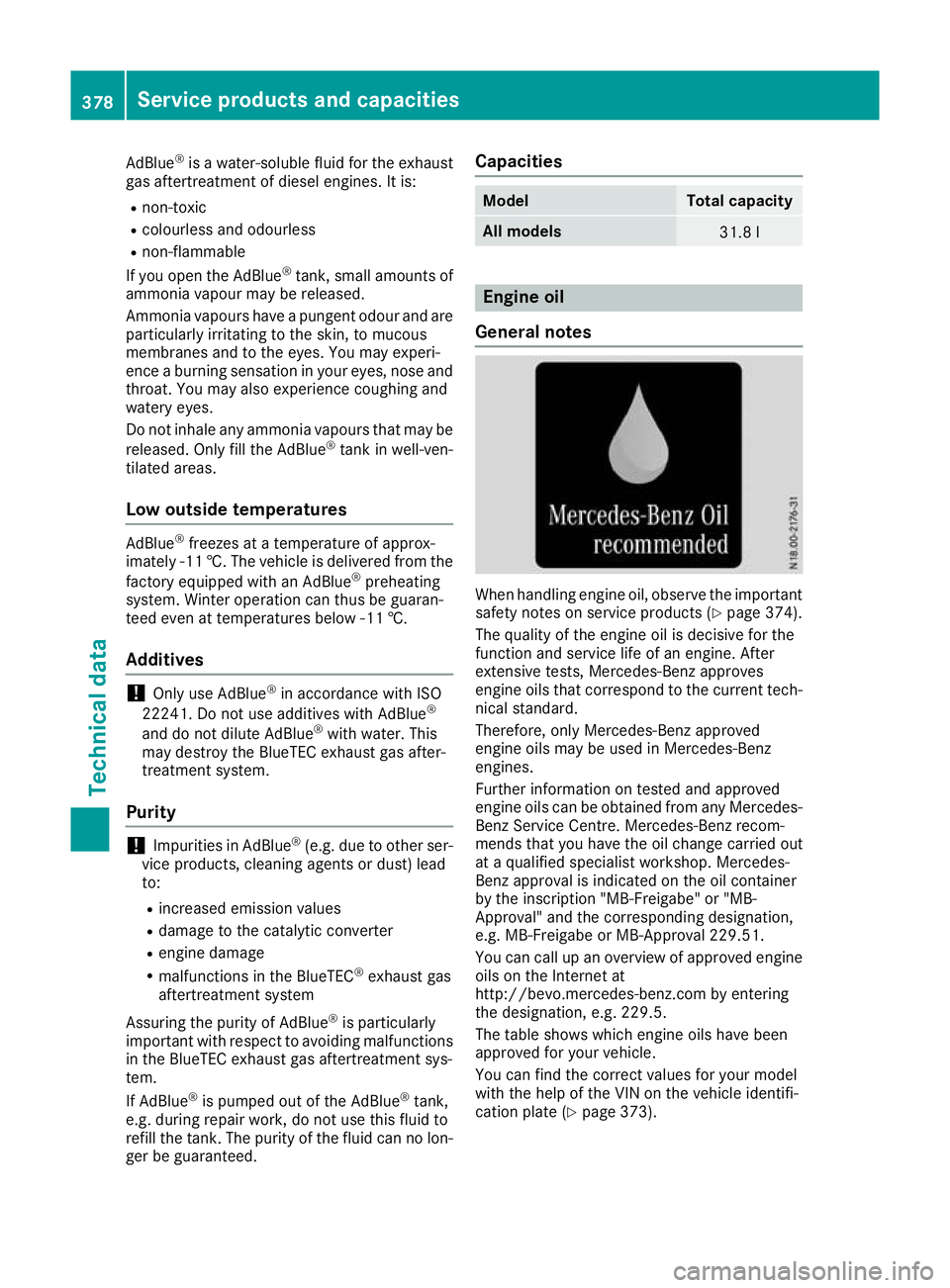
AdBlue
®
is a water-soluble fluid for the exhaust
gas aftertreatment of diesel engines. It is:
R non-toxic
R colourless and odourless
R non-flammable
If you open the AdBlue ®
tank, small amounts of
ammonia vapour may be released.
Ammonia vapours have a pungent odour and are
particularly irritating to the skin, to mucous
membranes and to the eyes. You may experi-
ence a burning sensation in your eyes, nose and throat. You may also experience coughing and
watery eyes.
Do not inhale any ammonia vapours that may be
released. Only fill the AdBlue ®
tank in well-ven-
tilated areas.
Low outside temperatures AdBlue
®
freezes at a temperature of approx-
imately -11 †. The vehicle is delivered from the
factory equipped with an AdBlue ®
preheating
system. Winter operation can thus be guaran-
teed even at temperatures below -11 †.
Additives !
Only use AdBlue ®
in accordance with ISO
22241. Do not use additives with AdBlue ®
and do not dilute AdBlue ®
with water. This
may destroy the BlueTEC exhaust gas after-
treatment system.
Purity !
Impurities in AdBlue ®
(e.g. due to other ser-
vice products, cleaning agents or dust) lead
to:
R increased emission values
R damage to the catalytic converter
R engine damage
R malfunctions in the BlueTEC ®
exhaust gas
aftertreatment system
Assuring the purity of AdBlue ®
is particularly
important with respect to avoiding malfunctions
in the BlueTEC exhaust gas aftertreatment sys-
tem.
If AdBlue ®
is pumped out of the AdBlue ®
tank,
e.g. during repair work, do not use this fluid to
refill the tank. The purity of the fluid can no lon-
ger be guaranteed. Capacities Model Total capacity
All models
31.8 l
Engine oil
General notes When handling engine oil, observe the important
safety notes on service products (Y page 374).
The quality of the engine oil is decisive for the
function and service life of an engine. After
extensive tests, Mercedes-Benz approves
engine oils that correspond to the current tech-
nical standard.
Therefore, only Mercedes-Benz approved
engine oils may be used in Mercedes-Benz
engines.
Further information on tested and approved
engine oils can be obtained from any Mercedes-
Benz Service Centre. Mercedes-Benz recom-
mends that you have the oil change carried out
at a qualified specialist workshop. Mercedes-
Benz approval is indicated on the oil container
by the inscription "MB-Freigabe" or "MB-
Approval" and the corresponding designation,
e.g. MB-Freigabe or MB-Approval 229.51.
You can call up an overview of approved engine oils on the Internet at
http://bevo.mercedes-benz.com by entering
the designation, e.g. 229.5.
The table shows which engine oils have been
approved for your vehicle.
You can find the correct values for your model
with the help of the VIN on the vehicle identifi-
cation plate (Y page 373).378
Service products and capacitiesTechnical data
Page 382 of 393
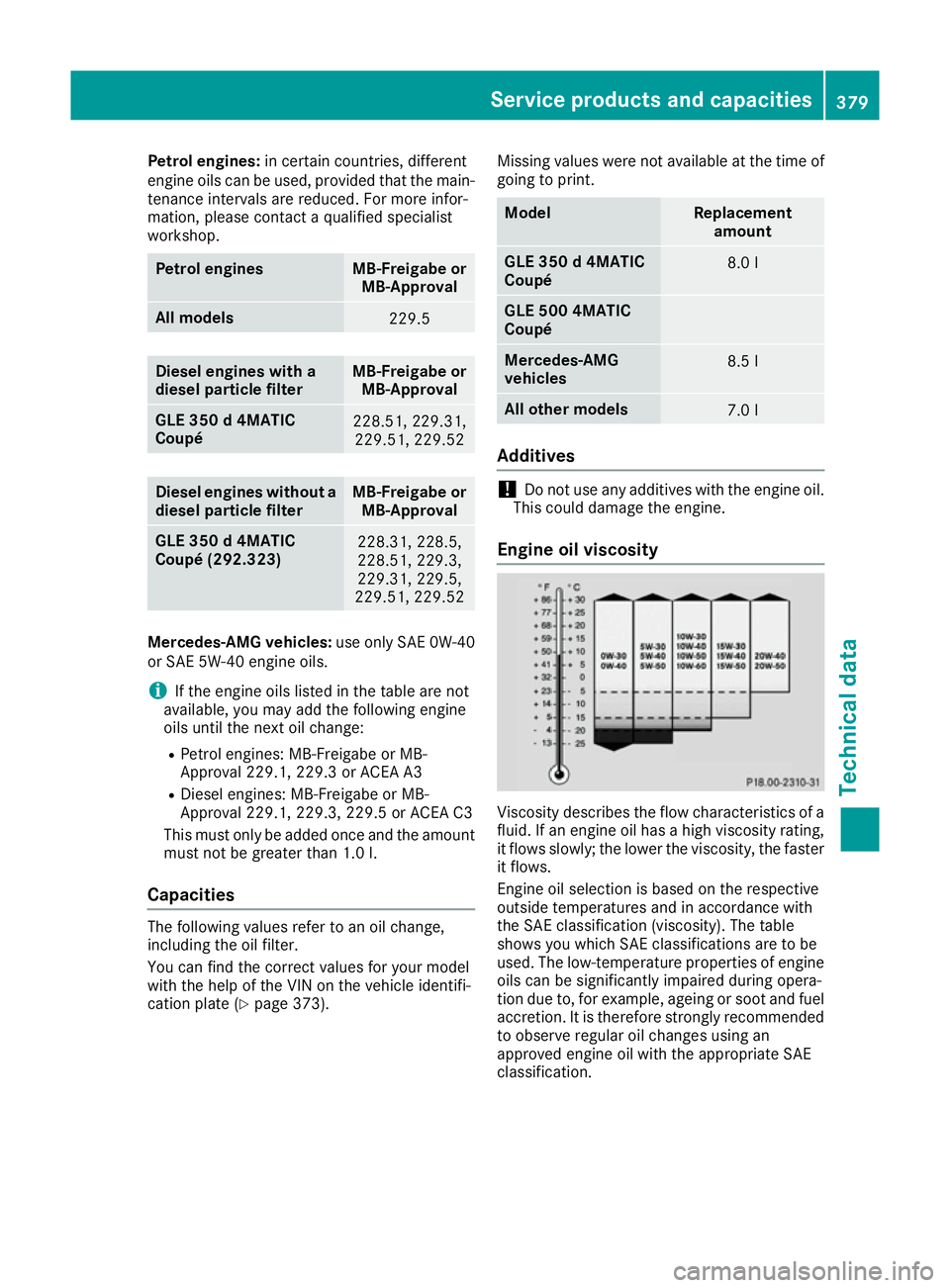
Petrol engines:
in certain countries, different
engine oils can be used, provided that the main-
tenance intervals are reduced. For more infor-
mation, please contact a qualified specialist
workshop. Petrol engines MB-Freigabe or
MB-Approval All models
229.5
Diesel engines with a
diesel particle filter MB-Freigabe or
MB-Approval GLE 350 d 4MATIC
Coupé
228.51, 229.31,
229.51, 229.52 Diesel engines without a
diesel particle filter MB-Freigabe or
MB-Approval GLE 350 d 4MATIC
Coupé (292.323)
228.31, 228.5,
228.51, 229.3,
229.31, 229.5,
229.51, 229.52 Mercedes‑AMG vehicles:
use only SAE 0W-40
or SAE 5W-40 engine oils.
i If the engine oils listed in the table are not
available, you may add the following engine
oils until the next oil change:
R Petrol engines: MB-Freigabe or MB-
Approval 229.1, 229.3 or ACEA A3
R Diesel engines: MB-Freigabe or MB-
Approval 229.1, 229.3, 229.5 or ACEA C3
This must only be added once and the amount must not be greater than 1.0 l.
Capacities The following values refer to an oil change,
including the oil filter.
You can find the correct values for your model
with the help of the VIN on the vehicle identifi-
cation plate (Y
page 373). Missing values were not available at the time of
going to print. Model Replacement
amount GLE 350 d 4MATIC
Coupé
8.0 l
GLE 500 4MATIC
Coupé
Mercedes-AMG
vehicles
8.5 l
All other models
7.0 l
Additives
!
Do not use any additives with the engine oil.
This could damage the engine.
Engine oil viscosity Viscosity describes the flow characteristics of a
fluid. If an engine oil has a high viscosity rating, it flows slowly; the lower the viscosity, the faster
it flows.
Engine oil selection is based on the respective
outside temperatures and in accordance with
the SAE classification (viscosity). The table
shows you which SAE classifications are to be
used. The low-temperature properties of engine
oils can be significantly impaired during opera-
tion due to, for example, ageing or soot and fuel
accretion. It is therefore strongly recommended to observe regular oil changes using an
approved engine oil with the appropriate SAE
classification. Service products and capacities
379Technical data Z